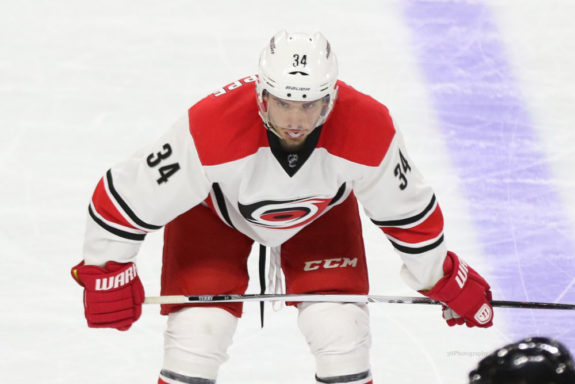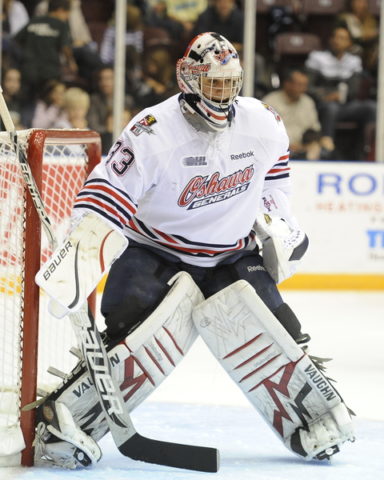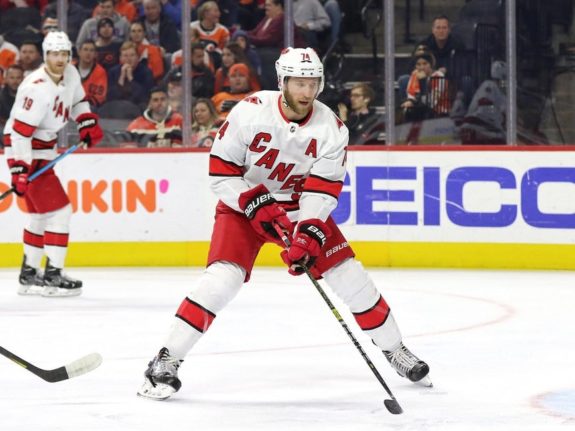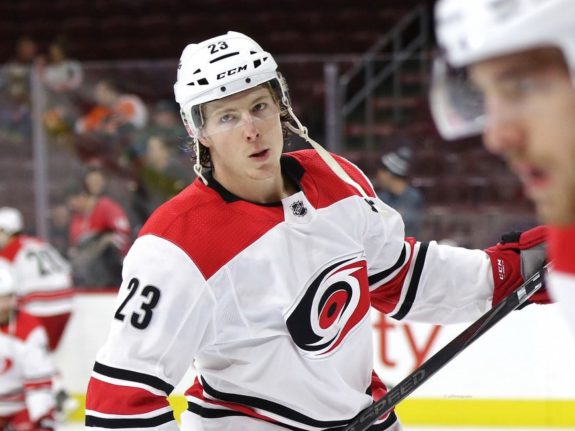The loyal fanbase of the Carolina Hurricanes went through a long period of suffering in the past decade, and oftentimes, they only had prospects as their reasons for optimism. Building through the draft was a major key for the team to get to their current era of postseason success. At the time, the 2012 Draft was supposed to be the start of the rebuild for Carolina.
On draft night, they owned 10 picks — which was tied for their most in franchise history after the move from Hartford in 1997. They owned the eighth overall pick, which was traded at the podium along with Brian Dumoulin and Brandon Sutter, for current Canes’ captain Jordan Staal. They still had nine picks after that deal, including six in the first four rounds. Let’s dive into how they did.
Second Round
38th Overall: F Phil Di Giuseppe
With no first-round pick, the Canes didn’t make a selection until early in the second round, when they took forward Phil Di Giuseppe. The entire Di Giuseppe saga was a weird one, as his tenure with the team was all over the map. When he broke into the NHL, he seemed to be emerging as a legit talent, posting 17 points in 41 games (a 34-point pace in a full 82-game season), and looked to have established some chemistry playing with Jeff Skinner.
The problem that has continuously plagued PDG throughout his pro career is his lack of hockey sense, and that’s a very difficult thing to overcome and find success at the NHL level. His feet never stop moving, and he’s a hard-working player, but his mind can’t keep up to his pace, and in turn, he has no idea what to do with the puck when he gets it. Combine that with stone hands and an average shot, and you’re left with a fourth-liner — at best — but a serviceable depth forward.

In essence, that type of a skillset isn’t typically what you’d expect from a second-round pick, but PDG has evolved into an NHL regular, which is more than a lot of former second-rounders can say. By that standard, I can’t just dismiss this pick as a disappointment, despite him not lighting the league on fire. He did play 147 games for the Hurricanes, and, now nine years removed from the draft, only seven of the other 29 second rounders have played more than Di Giuseppe’s 201 NHL games. So while not a flashy pick, it’s hard not to give it a solid grade.
Grade: B-
47th Overall: F Brock McGinn
As far as second-round picks go, it’s hard to find any criticisms with landing a guy like Brock McGinn in that position. Though a 40-goal season in his final OHL season may have heightened his offensive expectations higher than they should’ve been to some casual observers, McGinn was never a dynamic offensive talent at any level, and his modest draft-year production suggested that this pick was more about the unteachable qualities he possessed in his game.
As Hurricanes fans have seen over the years, McGinn’s relentless motor, outstanding presence on the penalty kill, and his overall energy level have made him a favourite in the fanbase. He’s a guy that has never cheated so much as even a half-stride and epitomizes everything that fits the mold of a Rod Brind’Amour-type player.
He’ll be forever etched in the Hurricanes’ history books as the guy who scored the Game 7 double-overtime winning goal against Washington in 2019, bringing an end to the team’s historic playoff drought that lasted nine years.
And although he’s never developed much of an offensive game, he’s become a guy that can chip in as a depth scorer, and if he had better puck luck, he would surely have better goal totals. It’s hard to nitpick with Brock, considering how many intangibles he brings to the team, and he’s truly an invaluable player on the ice and in the locker room. His future is a bit up in the air as he will be an unrestricted free agent this summer, but the general consensus is that McGinn should remain a Hurricane for the long haul. Great value in a weak second round.
Grade: A
Third Round
69th Overall: G Daniel Altshuller

When the Canes selected Altshuller, he immediately became the top goaltending prospect in the organization — but mostly by default. Their 2010 selection Fredrik Andersen had re-entered the draft, and the only other “prospect” in the system was Mike Murphy (who measured at 5-foot-10, 165 pounds). So suffice to say, Altshuller became the lone item in an empty cupboard.
He seemingly had it all. Great size (6-foot-4, 200 pounds), quick reflexes and a long run of success at the OHL level. Combined with the fact he was the only notable prospect at the position, the future looked super bright for Altshuller. But the fact has been beaten to death: goaltenders are voodoo, development is non-linear, and the unexpected should be expected. Despite what was a seemingly open road to stardom, throughout his entry-level contract, Altshuller played just 43 AHL games and another 38 in the ECHL, never appearing in a game for the Hurricanes.
By the time his ELC expired, the Canes had seen enough, and Altshuller was shown the door. I was mildly surprised at the time because I thought he’d shown some progression and was still only 22, but obviously, the team saw differently. From there, he committed to college. After two years of inactivity, Altshuller tried to revive his pro career with Brampton of the ECHL during the 2018-19 season, but he played in just two games and was then released. Now 26 years old, his Elite Prospects page lists him as retired.
Grade: D
Fourth Round
99th Overall: F Erik Karlsson
After passing on the two-time Norris-winning defenseman Erik Karlsson in 2008 to select Zach Boychuk instead, the Canes’ brass decided they couldn’t risk making the same mistake twice, and they opted to select Erik Karlsson — the winger — from Sweden in the fourth round. But as history would suggest, the Canes’ version of Karlsson didn’t quite reach the level the other one did.
When drafted, Karlsson was billed as a center with good speed and hockey sense but was an undersized player at 5-foot-10 and just 160 pounds. He played with a lot of intensity, but his overall offensive game was raw, especially projected at the pro level. He made the jump overseas in 2015 and played 91 games spanning two seasons with the Charlotte Checkers. In those games, he scored just 3 goals and 13 assists, which included his 42-game season in 2016-17, where he didn’t score a single goal.
Facing restricted free-agent status in the summer of 2017, Karlsson returned home to Sweden. The following month, the Canes decided not to tender a qualifying offer to him, and they no longer own his rights. Safe to say, his career was a far cry from what you’d expect when you hear the name “Erik Karlsson,” but you have to applaud the effort from the Canes here.
Grade: F
115th Overall: D Trevor Carrick
The Canes acquired this pick as a result of trading Joe Corvo for like the 47th time, so this selection was literally just playing with house money. They chose to add Trevor Carrick into the mix, a 6-foot-2, 196-pound rugged defender with a blazing slapshot. By the time it was all said and done, Carrick spent seven years in the Canes’ organization and played in 347 games for Charlotte of the AHL. He was also a huge part of their group that won the Calder Cup in 2019.
He was a guy that intrigued a lot of fans because of how long he stuck around, but Carrick only managed to suit up for just four games with the big club, and so they traded him to San Jose in August of 2019 — mostly to give him an opportunity elsewhere. But his skating has held him back from making the jump to the NHL level, and nearing his 27th birthday, he looks to be a career AHLer at this point. Carrick will have a long pro career and contributed a lot to the minor-league success in the organization. So while not flashy, this was a solid pick.
Grade: C+
120th Overall: D Jaccob Slavin
I mean, there’s not really a whole lot to say about this pick that a reader wouldn’t already know. The Canes acquired this pick in 2012 from the New Jersey Devils, along with defenseman Joe Sova, in exchange for forward Alexei Ponikarovsky. While Sova was obviously the real gem in the deal, Slavin turned out OK too!

In all seriousness, selecting Slavin this late in the draft was probably the biggest draft steal in Canes history, as well as the steal of the 2012 Draft as a whole. He’s a legitimate no. 1 defenseman in this league and is signed to an absolute bargain of a long-term contract with a $5.3 million AAV. If they had taken him with the eighth overall pick they traded for Staal, nobody would be complaining. It just doesn’t get any better than this.
Grade: A+
Fifth Round
129th Overall: F Brendan Woods
A two-time undrafted player when taken, the Canes were likely intrigued by Woods’ hulking 6-foot-4, 210-pound frame and the rugged style of hockey he played. If there’s one thing I can say about Woods, it was that he was consistent; consistently a bottom-six at every level he played at. His compete level got him into seven NHL games with Carolina, and although I watched all seven of them, I have very little recollection of any contributions he may or may not have made on the ice.
After leaving the Canes’ system as a free agent in 2017, Woods has bounced around the AHL since and has the look of being a long-tenured AHLer — if that’s the route he takes with his career. He’s only 28, and while he’s not an NHL talent, he’s already got over 300 games of AHL experience and is a valued contributor in the minors. At this spot, he’s expected value.
Grade: C
Sixth Round
159th Overall: G Collin Olson
This is one of the picks that I look back and shake my head about because, at one point in time, I really thought this guy was going to emerge as a steal. He had the size that NHL teams covet in net (6-foot-4, 215 pounds) and a prototypical but effective butterfly style, which made him a mainstay with the U.S. National Development Program. Though that was a weak year for that program, Olson was statistically the best of the four goaltenders on their roster.
Latest Hurricanes Content:
- Every NHL Team’s Most Underrated Prospect
- Hurricanes Conclude March’s Grueling Schedule on a High Note
- Carolina Hurricanes Clinch Sixth Straight Playoff Berth
- Hurricanes’ Jack Drury Proving He Belongs in Raleighwood
- Frederik Andersen’s Return Sparks Hurricanes Division Title Hunt
Unfortunately, things never progressed from there. He committed to Ohio State but transferred out of the program after starting just eight games in two years. He then looked on track for a potential career revival after two strong years in the USHL and transferred to Western Michigan. Once again, he was unable to adjust to the college ranks and was given just 11 starts in his two years there. He was 3-7-1 in those games with a .876 save percentage and had no resemblance to being a pro goaltender.
That was the end of the road for Olson, and the Canes never signed him to an entry-level deal. He retired from hockey after his senior year for WMU at age 23, and we’re left to wonder what could have been. He was always a long shot, but very early in the draft aftermath, I was more intrigued by Olson than I was by Altshuller. Both guys are an example of how voodoo goaltenders can be and how tough they can be to develop.
Grade: D
Seventh Round
189th Overall: F Brendan Collier
Honestly, I forgot this kid even existed until I started researching for this piece. I’ll keep it short. Collier was an undersized (5-9, 170lbs) center who never developed an offensive game at the college level. He spent one year at Boston University, then three years at Northeastern, before finishing his career off with a one-year stint in the ECHL. He was never signed by the Hurricanes and is now retired as a player. Nowadays, Collier is coaching the U17 high school hockey team that he established his own career playing for.
Grade: D
Recap
While there were a lot of misses in this class, the Canes also struck gold on a few of their picks. McGinn and Slavin have both become major pieces to the modern-day success of the franchise, and a handful of the others selected made valuable contributions to their AHL program, and even to a varying degree on the NHL side of things.

Not having a first-round pick was a bit sad, but the first round of this draft ended up being relatively weak, and the Canes did manage to land Teuvo Teravainen (who was a target for them at eighth overall) a few years later in a trade. The mid-round strikes — Altshuller and Karlsson specifically — lower the overall grade a little bit, but this is a draft class that should be looked back upon fondly for the team. It was a nice haul and was also key toward bringing in Jordan Staal. All in all, very solid.
Draft Grade: B